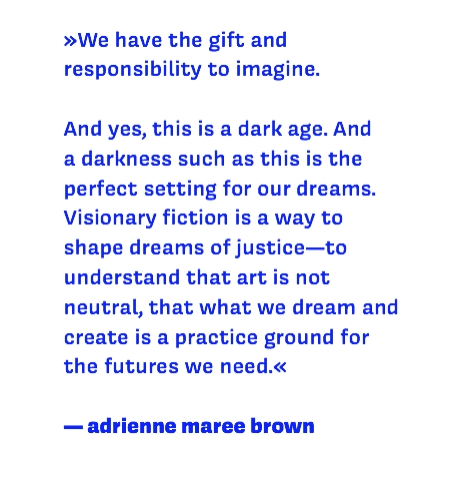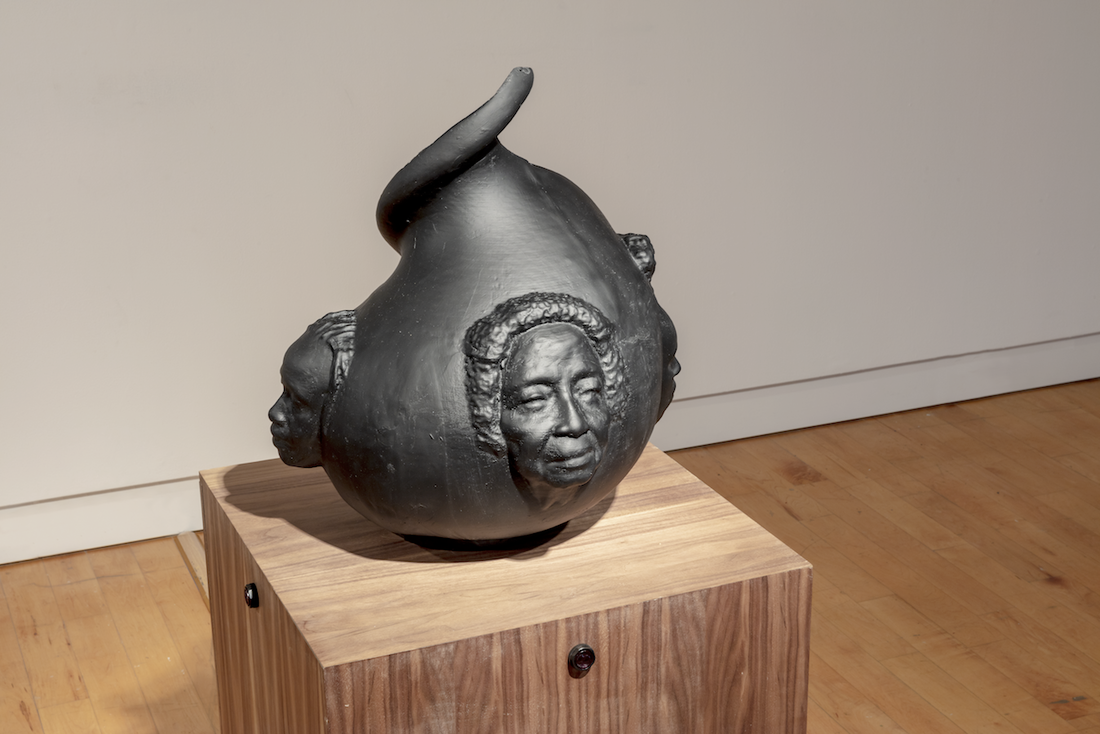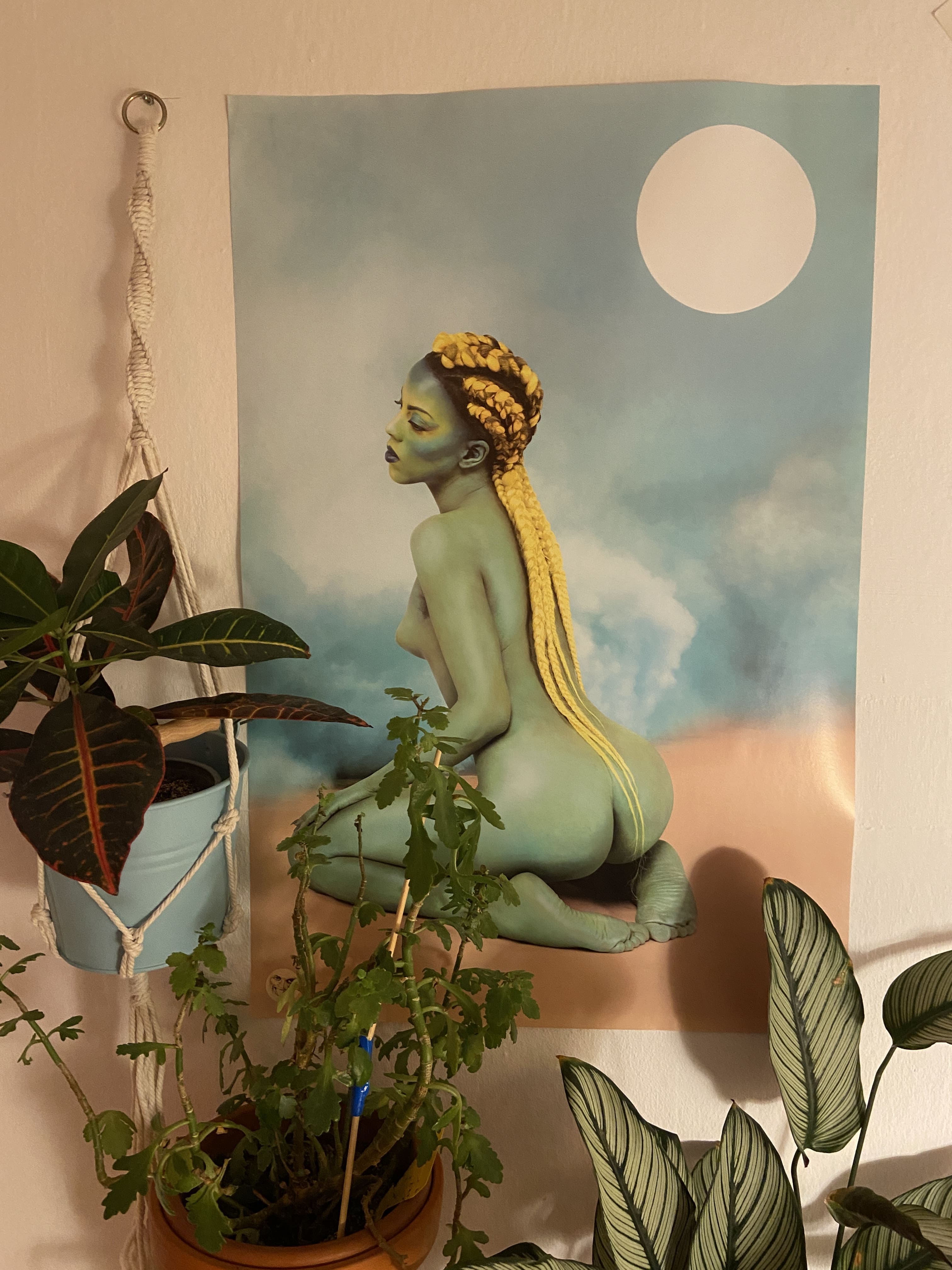What does our feminist future look like?
Ulla Heinrich & Nushin Yazdani
Carrier Bag
Future-Present Vibrations
Language :
en de
afrofuturism care carrier-bag categories-classifications communities facial-recognition gender healing imagination identity music non-binary planetary pop-culture queerness robots surveillance tech-solutionism visionary-fiction
Visions of the future that are developed beyond the closed doors of government offices and large companies often look like the series Black Mirror: individual global multinationals ruling the world, surveillance capitalism, cameras and screens everywhere, every interaction evaluated, analysed, and classified. In these depictions, people often live together with machines, and just as often there are conflicts, hierarchies, and oppression as a result.
Our ideas about technology also shape technology. Likewise, when we call data ‘the new oil’, as researcher Maya Ganesh puts it, it shapes how we see data and work with it. ‘Such metaphors determine how a technology is developed, built, and will be regulated (or not regulated)’, she writes.
Many tech companies let Hollywood's science-fiction imaginations influence [LINK Technology Review] their product development. This doesn’t just include the iPad and the smartwatch. Predictive policing systems are no longer far removed from the monitoring concept of the sci-fi classic “Minority Report”. Today, racialized people in the USA, the UK and elsewhere are disproportionately and unjustifiably monitored and prejudged by such systems. In the Chinese region of Xinjiang, facial recognition, wi-fi bugs, and spying programs are used to classify Uyghurs and other Muslims and imprison them in torture and forced la-bor camps.
Often those who feel the violent effects of new technologies are people who are marginalised in their countries and/or live in the Global South. In ‘Cheat Sheet for a Non- (or Less-) Colonialist Speculative Design’, Pedro Oliveira and Luiza Pra-do urge us to ask ourselves when imagining futures: ‘“Does my dystopia happen already in other 'invisible' (sic) places of the World?” It is good to know if what would be terrible for you and your audience isn't already reality for others.’
Colonialism and its impacts, which are still strong today, have contributed to these conditions. The extractivist approach to technology’s raw materials and also to data, such as photos for training facial recognition systems, bears neocolonial traits. Scholar Michael Kwet analyses how digital services from the US are destroying local markets around the world and calls for speaking of Silicon Valley as an imperial power.
Our future seems to be determined by data colonialism, extractivism, competitiveness, and all-destroying desires for growth. It feels so much easier to dream of dystopian visions than to create concrete ideas for worlds that will be plural and worth living in for everyone. These are all the more important. We can only live in a more just world if we dare to imagine it first.

adrienne maree brown (2019). Excerpt from „Dream Beyond the Wounds“. Ding Magazine.
This virtual carrier bag, put together by Nushin Yazdani and Ulla Heinrich from the queer feminist collective dgtl fmnsm, is an invitation to immerse yourself in a stimulating and utopian world. A world in which artists and activists have long been laboring together on alternative futures from a feminist perspective - both aesthetically and politically. The selected videos, texts, works of art and audio pieces are made by people who help us to focus on the transformative potential of collective efforts – by dreaming up new futures together.
We recommend viewing the following contributions, one after the other, in a relaxed setting. You are welcome to take breaks and come back later or meander through the www from the posts.
Perhaps you can get comfortable, brew your favorite tea, dim the lights? Perhaps you can raise your nose into the fresh air, feel in your body how you and it are doing right now, pamper yourself with a loving compliment, put both feet firmly on the ground and inhale and exhale deeply. In order to fight for an alternate future, we must first take care of ourselves in this destructive world.
Let’s get started.
🔹 Enjoy the following video, a collaboration from heaven, between the British musician Oyinda and visual artist duo Pussykrew. Please view it in full screen mode: Oyinda “Serpentine”.
Welcome back! How does the video make you feel? What's the first word that springs to mind? Can you imagine your virtual avatar leaping, from the platform, into a new future alongside Oyinda in this fluid world of glittering data plants and sensual cables? And if so, what should this future look like?
🔹 In her time travel novel “Woman at the Edge of Time”, published in 1976, feminist author Marge Piercy shows what a livable, plural and decolonial future could look like. The protagonist Connie Ramos, detained in a psychiatric hospital due to poverty, racism and patriarchal violence, escapes this harrowing reality through a time-traveling person, Luciente, who brings her into their life in 2137, to ensure that Luciente’s future will indeed become a reality. The points of friction and the incomprehension of Connie and Luciente for each other’s worlds shake the image of normality, with which Connie and we as the readers view their everyday lives.
During their first conversation, Connie asks Luciente: “You're a college graduate?” (...) – “What's that?” They stared at each other in mutual confusion. “Where you go to study. To get a degree,” Connie snapped. “A degree of heat? No... as a hierarchical society, you have degrees of rank? Like lords and counts?”
Piercy describes a world in which there are no hierarchies, only roles. In which everyone who wants can “mother”. There are no more genders. Sustainability is integrated into all processes in a high-tech society; this is not a contradiction in terms. Pain, jealousy and death continue to accompany people, but good ways have been found in Luciente's world to deal with them together.
The book is currently not in print. You can find it in online secondhand book shops – a sustainable concept that is worth supporting.
#HerStory #FeministClassics #VisionaryFiction #FeministFutures
🔹 “Don't touch my hair when it's the feelings I wear” whispers the RnB singer Solange decisively in her neo-soul song of the same name. In the exhibition and 3D world “NeuroSpeculative AfroFeminism” (NSAF), viewers enter a hairdressing salon, immersing themselves in the world of a Neuro Cosmetology Lab. In this aesthetically very impressive reimagined Black hair salon, rituals of hair care can be experienced from the perspective of a Black young girl. At the same time, the audience plunges into an afrofuturistic alternative present, in which hair-braiding is used in historical continuity as a nec-essary form of empowerment, namely for brain research and neuromodulation.
Open this 53 second trailer in a new tab and watch it in full screen mode:
How do you perceive the atmosphere of what you've just seen?
In addition to the VR experience, molecular biologist and artist Ashley Baccus-Clark and the Hyphen Labs studio have cre-ated various artifacts that tell the story of NSAF outside of virtual space: the Octavia Electrodes (brain-stimulating braids), the Scaterviz (a micro-aggression-dissipating visor) and others.
Hyphen Labs works at the intersection of technology, art, science and futurism and collaborates exclusively with Black Women and Women of Color: : http://www.hyphen-labs.com
#Futurism #Interaction #Neuroscience #BlackMagic
🔹 In her project “Not the only one”, artist Stephanie Dinkins shows how artificial intelligence can function as a progressive social and artistic tool. Dinkins designed an object that tells stories of under-represented people in the tech sector - literally: A sculpture that is also an interactive deep learning system with which real conversation is possible. The object was trained using voice data obtained from three generations of women in Dinkins’ family. Dinkins calls it an “attempt to create a multigenerational memoir of a black American family told from the perspective of an artificial intelligence of evolving intellect.”

Photo credit: Stephanie Dinkins
“Not the only one” is a visionary counter-narrative to what AI is today: a deeply personal object that was created to connect people, not to separate them from one another through artificially created categories.
If you want to find out more about the object, you can experience it in action together with the artist here:
#AI #DeepLearning #Multigenerational #VisionaryAI
🔹 ”I do what I wanna do when I wanna do it”. It is clear that a feminist future will not run binary along heteronormative, sexist and stereotyped gender boundaries – and this is one of the reasons we look forward to this reality so much. One of the most impressive non-binary cyborgs is the Venezuelan musician Arca, who continues to set new standards with her queer futurism.
Open Arca's song “Nonbinary” in a new tab and be enchanted and confused.
What does our future look like without gender boundaries? What would change in your life if the binary gender system no longer existed?
#NonBinary #Transfeminism #DeconstructedBodies #Music
🔹 Danielle Brathwaite-Shirley's “Black Trans Archive” radically reinterprets the archive term and puts questions of “permanent storage” in a political context. The media artwork, which can be viewed in the browser, is an interactive and gripping experience, a visually extraordinary and emotionally moving game that reverses hegemony and centers Black trans people – as Danielle writes: “to remember us even when we are at risk of being erased.”
Click here for the “Black Trans Archive”: https://www.daniellebrathwaiteshirley.com/blacktransarchive-com
#BlackTransPolitics #AlternativeArchive #PoliticalGaming #DeErasure
🔹”Close isn't Home” is a free resource archive for 3D objects that are culturally and regionally specific. The artists Grace Kwon and Sam Vassor want to counteract the homogeneity of 3D objects available online in a very practical way and increase the accessibility of 3D technologies for BIPoC. Numerous artists have donated 3D objects for this special li-brary.
Have a look around the library here: https://closeisnthome.com/3D-Library
Which object triggered something in you? Which personal object is so important to you that you want it in the 3D library?
In addition to the 3D resource platform, “Close isn't Home” is also the multidisciplinary collective of Samantha Vassor and Grace Kwon. They work together on 3D, design and interactive digital art projects and bring “the portrayal of their 'niche’ experiences to mainstream media.”
#3D #AlternativeLibraries #PoliticalDesign #DesignJustice #Unity #Unreal #Worldbuilding
🔹 Reproduction, patriarchy and capitalism are inextricably linked. In their hybrid VR performance “Virtual Wombs”, Anna Fries and Malu Peeters examine how we can imagine pregnancies that take place outside of this matrix. Pregnancy is thought of beyond binary gender concepts and even beyond the human body. In an immersive journey, viewers float through speculative spheres and encounter queer and pregnant bodies that share their intimate stories.
You can find the trailer for the virtual theater experience here:
Do you have any idea what pregnancy without binary genders might look like? What future visions do we have as a soci-ety for pregnancy and parenting?
#QueeringPregnancy #PostHuman #VR #Theater
🔹One of the most famous visionary fiction writers is Octavia Butler. Butler's World in the Parables (Parable of the Sow-er & Parable of the Talents) shows a hard and painful future, in which the apocalypse is not caused by aliens or a sudden comet, but comes creeping – with the advanced climate crisis and privatization and commodification of everything that can somehow be commodified. Butler contrasts this strong criticism of destructive capitalism with a group around the protagonist Lauren Olamina, who defy the adversity and build a community through adaptability and empathy. In the Parables, Olamina creates a new religious-spiritual movement; however, at the center, there are no dogmas or gods, but rather change that can be actively shaped and influenced:
“All that you touch
You Change.
All that you Change
Changes you.
The only lasting truth is Change.
God is Change.”
#VisionaryFiction #FeministLiterature #HowToSurviveTheEndOfTheWorld #AllYouTouch #Parables
🔹 And if there should be goddesses in the feminist future, then one of them would be the poet, musician and visual artist Juliana Huxtable.

(Foto aus Ullas Zimmer)
Juliana Huxtable: Untitled in the Rage (Nibiru Cataclysm), 2015
Live-Set at Nyege Nyege Festival
#Multimedia #IntersectionalFeminist #VisionaryBodies #DeconstructedSounds
🔹 Cleo Kempe Towers, also known as Emotional Labor Queen, is a Berlin based visual artist, writer and Jewitch. Work-ing on topics such as power dynamics, ritual obsession, emotional labor, femme survival and astrological healing, Towers produces a monthly podcast called “Emotional Labor Queen” which focuses on healing from queer to queer and all mat-ters of the heart. Emotional Labor Queen provides their 13,000 followers with Quality Meme Content 4 the matters of the heart on Instagram. For self-care in times of crisis with rose quartz blessings:
https://www.instagram.com/p/CVIjtTJsbec/
https://www.instagram.com/p/CSwzCMUMYiJ/
https://www.instagram.com/p/CQHF9cEnkxf/
https://www.instagram.com/p/CPYBlUoHwoR/
https://www.instagram.com/p/CLMQFFfHOk0/
https://www.instagram.com/p/CKlZlrDHiat/
#MemeCore #Selfcare #Jewitch #EmotionalLabor
🔹 Which bodies are recognized as desirable and who is allowed to experience pleasure with which body is socially limited by heteronorms, capitalized beauty compulsions and colonialism. For decades, the sex-positive movement has been us-ing feminist and queer pornography to create pleasurable alternatives to restrictive and discriminatory norms and im-part knowledge about body, gender and lust against shame. Sex is and will remain political. AORTA film produce exactly the images that we need for an emancipatory and liberated future, in which we can groan loudly together (for everyone who wants). In the short film “Orgy #1”, not only have many principles of feminist pornography been implemented, the material is also just fucking hot!
Passwort: carrierbagxaorta
What did you see? What did you like? What did you dislike? What turned you on? Have you found your desire again? What would your ideal future porn look like?
#FeministPorn #Queercore #Sex #HotMess
🔹 At the moment there are many good reasons for hibernation, for rest, for breaks. “Sonic Hibernation” is a semi-fictional fantasy story and DJ set by Zambian-Dutch artist Happy New Tears that takes place in 2020 between Apollox and an unknown character as the world is facing a pandemic due to a new rapidly spreading virus. The only cure is to seek refuge in a sonic hibernation. Close your eyes and let this visual set take you far outside of your quarantine room and into the deep online forests for a meditative dance session:
#DeconstructedClub #FeministFantasy #MediativeDanceSession #Music
🔹🔹🔹 The visionary fictions described above have similar values. BIPOC and FLINTA* are written in the future or write themselves in the future, and live solidarity and self-development within a community, live other ideas of work and per-formance, respect and preservation of nature, more connectedness and value for body and emotion, chosen families and queer lifestyles. Above all, it is crucial to make these ideas tangible, describable and thus viable. Or, as adrienne maree brown and Walidah Imarisha call it, to shape reality out of our dreams.
🔹🔹🔹 What would be in your carrier bag?
Let us know if you like!
Until next time,
Nushin & Ulla
A part of this text was first published on the website of the Gunda Werner Institute, in the article “Die Zukunft muss nicht aussehen wie in Black Mirror" by Nushin Yazdani.